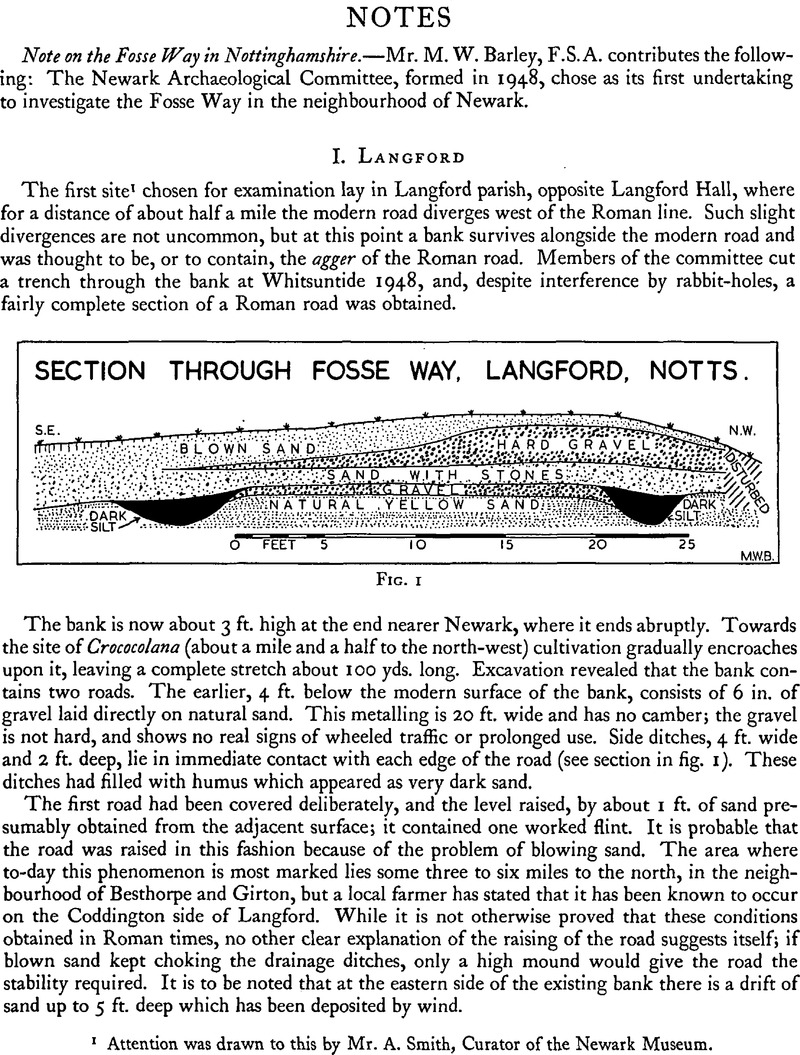No CrossRef data available.
Article contents
Note on the Fosse Way in Nottinghamshire
Published online by Cambridge University Press: 29 November 2011
Abstract

- Type
- Notes
- Information
- Copyright
- Copyright © The Society of Antiquaries of London 1950
References
page 64 note 1 Attention was drawn to this by Mr. A. Smith, Curator of the Newark Museum.
page 65 note 1 See Throton Society Transactions, 1938; A. Oswald, ‘Excavations at Ad Pontem’ p. 2 and plan n p. 11. The committee is indebted to Mr. W. R. Bissill and Mr. P. H. Cramer for permission to excavate.
page 65 note 2 The mound has been thought to be a tumulus, and Bronze Age flint implements have been found about 200 yds. away to the south; it has also been conjectured that it might be the collapsed gate of the town of Ad Pontem. The presumed site of this station, where Mr. Oswald's excavation revealed civil occupation of the first to fourth centuries, lies half a mile to the north, alongside the present road.
page 65 note 3 A Roman occupation site is exposed in the present bank of the Trent, 200 yds. north-west of this excavation.
page 66 note 1 See Oswald, A., ‘Some Unrecorded Earthworks in Nottinghamshire’, in Thoroton Society Transactions, 1939, p. 7 and pl. 1.Google Scholar
page 66 note 2 The Newark Archaeological Committee is very grateful to Mr. Neale for his ready consent, and for his tolerance of some interference with his farming operations.
page 66 note 3 K. M. Kenyon, Excavations at the Jewry Wall Site, Leicester, Society of Antiquaries, Research Report No. 15, 1948, p. 40.
page 66 note 4 See Oswald, F., ‘Roman Road of Nottinghamshire’, in Nottinghamshire Countryside, July 1947, p. 6.Google Scholar
page 66 note 5 See Oswald, F., ‘Margidunum’, in Thoroton Society Transactions, 1927, pp. 66–7.Google Scholar
page 66 note 6 Throsby's, Thoroton, i, p. 149.Google Scholar
page 66 note 7 Stukeley, quoted in V.C.H., Notts, ii, p. 8.
page 66 note 8 History of Collingham, Newark, 1867, p. 3Google Scholar
page 67 note 1 I am very grateful to the Rev. M. V. Hardy, Vicar of Flintham, for allowing me to see these accounts.
page 67 note 2 Recent examination of the site on the ground and from the air suggests that it was surrounded by a rampart composed partly at least of clay and double ditches astride the road, like the civil site at Margidunum. Dr. J. K. St. Joseph has made available his air photographs, and Mr. K. D. M. Dauncey has examined the site. The writer is grateful to both, and particularly to the latter for thus allowing his tentative conclusions to be published.
page 67 note 3 K. M. Kenyon, op. cit., p. 39. I should like to express my debt to Dr. I. A. Richmond and to Mr. Philip Corder for their advice on this inquiry while it was being conducted, and particularly to Dr. Richmond for reading this description of it. I am also grateful to Mr. M. H. Callender for comments on the fragments of amphora found at Langford.




